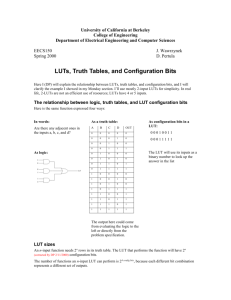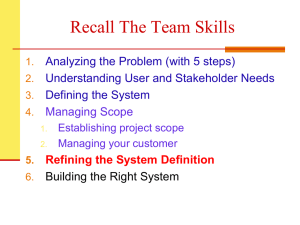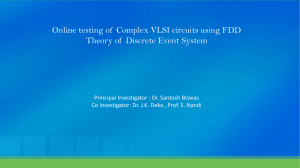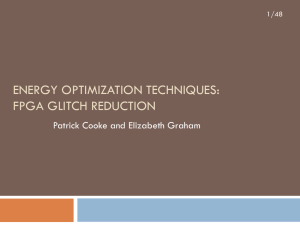Fracturable luts
advertisement
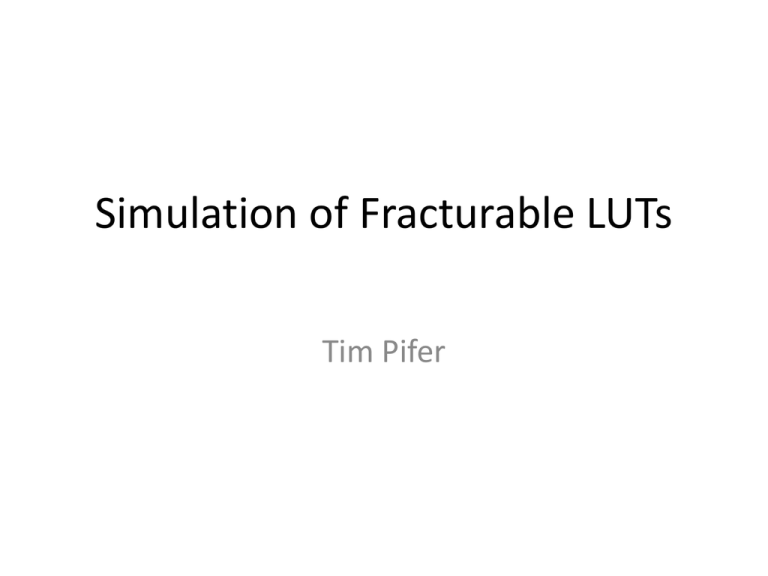
Simulation of Fracturable LUTs Tim Pifer Presentation Overview • Altera ALM from Stratix II • Stratix V architecture • Current VPR method for Fracturable LUTS – Wiremap for technology mapping – AApack for packing Altera Adaptive Logic Module • Traditional 4LUTs provide the best area-delay product • Larger LUTs – – – – Shorter critical path Absorb more logic Larger LUT mask More input Muxing • reduce critical path depth by 20% , improving area Improving FPGA Performance and Area Using an Adaptive Logic Module Mike Hutton, Jay Schleicher, David Lewis, Bruce Pedersen, Richard Yuan, Sinan Kaptanoglu, Gregg Baeckler, Boris Ratchev, Ketan Padalia, Mark Bourgeault, Andy Lee, Henry Kim and Rahul Saini Motivation from other architectures • • • • • BLE5 - 15% fewer LUTs , 25% shorter unit delay BLE6 - 22% fewer LUTs , 36% shorter unit delay BLE7 - 28% fewer LUTs , 46% shorter unit delay K=6 25% 6LUT Example design – K=4 100 LUTs – K=6 78 LUTs : 23 6LUT,32 5LUT,17 4LUT,9 3LUT,13 2LUT • Stratix, VirtexII : 30:1 input mux • relative contribution of routing area and interconnect delay increase with each generation of fabrication Simple Example: 6LUT from 4BLEs • Larger Area • 19 input, 4 registers • For 6-LUT, 4LUTs have identical inputs, separate input muxes • 3 /4 registers, outputs wasted Improved Example: 6,2 Fracturable LE • 8 Inputs, 2 outputs, 2 registers • 1 6LUT • 2 5LUTs with input Sharing • 2 independent 4 LUTS • comparable in area with two BLE4 • Functionally closer to two BLE5 logic elements. Final Version • • • • • • • • • Composed of 3LUTs Added d2 muxed output c1 or GND ,c2 or VCC muxed remove mux from d1 swap muxes controlled by R and T two 6LUTs share 4 inputs, identical LUT-mask 4:1 muxes, common data, different select lines Up to 12% pairs of 6-LUTs R=0 T=1 S=1 implements 2 muxed 5Luts with 7 inputs – F1 = fn(a1,a2,b1,b2,d1) – F2 = fn(a1,a2,b2,c2,d1) – Out = mux(F1,F2,c1) • roughly area-neutral with BLE4 and 36% decrease in logic depth How do we set RSTU for a 6LUT? 8:1 mux implementation • 8:1 mux in 2 ALMs (4 ALUTs) using 7 input functions • second ALM computes output – F1=fn(s0,s1,d3,y0,y1) – F2=fn(s0,s1,d7,y0,y1) – mux controlled by s2 • 5 BLE4 vs. 2 ALMs, saves one BLE4 Stratix V • ALM can become 2 4LUTS • eight inputs for both ALUTs • backwardcompatible with 4LUT architectures Logic Array Blocks and Adaptive Logic Modules in Stratix V Devices Stratix V Normal Modes Normal LUT mode • single 6LUT mode, other inputs used for registers Extended LUT mode • 7 input function • 2-to-1 multiplexer with two 5LUTS sharing 4 inputs. • If Else statements Why 6LUTS: DES Example • DES : 8 sboxes or substitution tables • sbox has 6 inputs, 4 outputs • Each output: – 1 6LUT – 6 4LUTs. • 35-45% less area How would we alter technology mapping to best support FLUTs? Technology Mapping • 1 4LUT and 2 6LUTs requiring 3 ALMs • Could use 4 5LUTs requiring 2 ALMs and the same logic depth Balancing Technology Mapping • Must maintain optimal critical path depth, more packable LUT distribution • avoid 6-LUTs when not helping delay • 8:1 muxes identified separately and mapped to 7 input functions • 7% of ALMs are 7-input functions Results: Performance • 80 designs tested • 130nm process • Minimum chip size used • Spice models for delay Results: Area Stratix vs. Stratix II Conclusions • Benefits of 6LUTS without underutilization • Larger LUT Costs: – LUT-mask size – input and output muxing – FFs • 6-LUT is fracturable into 5 LUTs, area comparable to 2 BLE4s • 7-input functions and 6 input pairs • Technology mapping support is needed for best results • 6,2 Alm vs 4BLE: – 15% better performance – 12% smaller area average How do we need to alter VPR to support FLUTs? AAPack and wiremap • ABC with Wiremap technology mapping to primitives • AApack- capable of packing complex logic blocks based on logic primitives Wiremap • reduces 6LUTs percentage • Does not increase: – logic depth – total LUT count WireMap: FPGA Technology Mapping for Improved Routability Stephen Jang, Billy Chan, Kevin Chung, Alan Mishchenko AAPack Overview • Current tools can’t support the complexity of logic blocks • New logic block description language: – Depict complex interconnects – Hierarchy – Modes of operation • • • • Can pack complex blocks Area driven Area is compared to the theoretical minimum Verilog input for large benchmarks Architecture Description and Packing for Logic Blocks with Hierarchy, Modes and Complex Interconnect Jason Luu, Jason Anderson, and Jonathan Rose Example: Virtex-6 Logic Block • Tools don’t support Stratix IV or Virtex 6 • Virtex 6: – complex soft logic blocks – hard memories – multipliers What AAPack does • Can describe: – complex logic blocks with arbitrary internal routing structures – Variable memory configurations: 4Kx8, or 8Kx4, or 16Kx2 • area-driven packing • inputs: – user design – architectural description Complex Block Description Language • Expressive: The language should be capable of describing a wide range of complex blocks. • Simple: The language constructs should match closely with an FPGA architect’s existing knowledge and intuition. • Concise: The language should permit complex blocks to be described as concisely as possible. Physical blocks • Specified in XML • Hierarchy – Other blocks and – existing primitives • Inputs and outputs and clocks with pin numbers Primitives • Common primitives are handled in the language • LUTs inputs can be reordered, a memory address cannot Intra-Block Interconnect • Complete: crossbar switch –internal programmable signal • direct: direct connection- wire connection, no programmability • mux: multiplexed connection single-bit/bus - programmable signal Modes of Operation • Mutually exclusive functionality • Represent FPGA structures being used in different ways Packing Algorithm • Input: technology mapped Netlist, XML architecture • Output: Packed complex blocks • Greedy algorithm similar to other packing methods • while until all blocks are packed • Seed block s selected and packed • New complex block B for s • Pack additional blocks into B – Choose a compatible block c – Pack c into B if valid • Add B to Packed list Selecting Netlist and Complex Blocks • Choose the block with the most nets attached • Candidates are selected based on affinity in equation 1 • Affinity = shared nets and connections divided by the number of pins the new block would add. • Connections is a measure of how likely the new block will need external connections • Alpha is set to .9 Legality: Location • attempting to pack: – chooses a location – verifies routing • traversing the complex block as a tree • ordered smallest to largest right to left • traversed right to left to ensure smallest resource consumption • attempts to pack the other nodes in the subtree: find a flip flop for a LUT • 30 packs on the sub-tree Legality: Routablility • Initially, check if packing would exceeded external pin count • Then, generate routing graph for complex block • Assume any output can connect to any input of a complex block (switchbox architecture) • Apply pathfinder Memory • Primitives are technology mapped with a single bit width • 256 X 8 memory mapped as 8 256X 1 bit memories • primitives mapped to same component if bus signals identical Limitations • No support for timing in this implementation • primitive can map to only one complex logic block – flip flop can only be used in a LUT complex block, they cannot also be present in Multiplier complex blocks What are some faults of this packing method? Experiments • Verilog benchmarks • soft processors • image processors Fracturable LUTS • CLBs: – fully connected BLEs – FI X N – no pin sharing – 8 BLEs • BLEs : – 1FLUT – 2 flip flops – 2 outputs • FlUTs: – 2 Modes • 6Lut • Dual 5LUTs – Variable number of inputs – Dual mode input sharing depends on number of inputs FLUT Evaluation • Compare achieved area with the lower bound • Lower bound: number of complex blocks needed to contain the primitives without routing considerations • Efficiency : ratio of the achieved number of logic blocks and this value Efficiency Results • Number of inputs FI varied 5 – 10 • Geometric average across 5 benchmarks • 5 indicates all inputs are shared, 10 indicates no inputs are shared • 6 or 7 achieves tolerable efficiency Logic blocks and Channel width with number of inputs • # blocks decreases to 7 • Channel width from # inputs – first increases from more routing to each block – then decreases after 7: full efficiency so easier routing Memory • Varied # bits and max width • best utilization: smallest size, maximum width CLB consumption with memory size • Smaller memories: more logic due to muxes • Best results: multiple memory sizes Conclusions • New language can describe complex architectures using: – Hierarchy – Modes – Arbitrary interconnects • Packing algorithm for this architecture • Verified on large benchmarks • Needs timing driven packing How can we get additional improvement from technology mapping? Academic FLUTs soft logic • 4 architectures : –K=6 – M = 5,6,7,8 • M5: dual-output 6LUT of a Xilinx Virtex 5 • M8: Stratix II ALM Exploring FPGA Technology Mapping for Fracturable LUT Minimization David Dickin, Lesley Shannon BLE • BLE: – 1 FLUT – 2 Registers – 8 inputs – 4 outputs LUT Balancing Experiments • WireMap - no LUT balancing • WireMap - with LUT balancing • increase the cost of LUT5, LUT6 from 1.0 to 2.5 in 0.1 increments • Smaller LUT weighs unchanged Varying 6LUT weight Varying 5LUT and 6LUT weight Different Architectures Clock Frequency FLUT Reduction by Architecture


